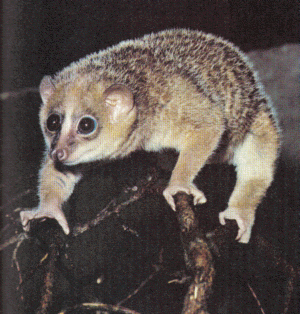 SKC Films Library |
| SKC Films Library >> Science >> Zoology >> Mammals >> Order Primates |
| Angwantibo Arctocebus calabarensis (aka Golden Potto)
Description An adult angwantibo is 9 to 12 inches long and weighs between 9.3 and 16.3 ounces. The limbs are proportionately long, while the tail is a mere stub hidden in the fur. The ears are naked and the hands and feet only sparsely covered. There are two subspecies. One has yellowish-brown or fawn fur with whitish underparts; the other is generally golden-red above with grayish underparts. Both have thick, wool-like fur with a golden sheen, which accounts for the angwantibo's alternate name. The hands and feet of the angwantibo are its most distinctive features. The palms of the hands are naked. The thumb is much larger than the rest of the fingers, to which it is strongly opposed. The first finger is reduced to a tubercule, and the remaining three fingers are invested at the base in a common skin. At the base of the thumb is a thorny, fleshy pad. This arrangement of digits makes the hands look somewhat like calipers (hence its species name) and allows for a very strong grip. The foot is stronger and larger than the hand, but has the same division into two opposing portions. On one side is the large and well-developed big toe, which has a fleshy tubercule at its base. The remaining four toes are well-developed and are also joined in a common skin at their bases. Distribution and Habitat Angwantibos are native to western equatorial Africa, and found in Cameroon, Equatorial Guinea, Nigeria and Zaire. It lives in primary and secondary forests, foraging within the lower canopy. Reproduction The breeding season begins in the middle of the dry season and lasts until the start of the wet season. Males are polygymous, but females typically only mate once per cycle. One offspring is born after a gestation of 131 to 136 days. At birth, the young are able to cling to the mother's fur and have their eyes open, but are otherwise unable to care for themselves. At first the baby clings to its mother's belly, but later will ride pick-a-back; the mother will sometimes leave it clinging upside down to a branch while she forages. Young are weaned at three or four months of age, and leave the mother's home range at about six months. All parental care is handled by the mother. Some females may give birth twice per breeding season. Angwantibos have an average lifespan of 12 to 15 years in the wild. Diet Caterpillars make up the majority of the angwantibo's diet, with beetles, ants, moths and crickets also of importance. Before eating a caterpillar, an angwantibo will rub the caterpillar in its hands to remove any hair that may cause irritation. Angwantibos will also eat fruits and gums, but only to a limited degree. Other Habits and Behaviors Angwantibos are solitary animals who forage and sleep alone, coming together solely for mating purposes. They are nocturnal, being most active at dawn and dusk. Despite their clumsy-looking appearance, angwantibos are very active and agile, moving with great ease through the lower canopy. Scientific Classification phylum Chordata |
| SKC Films Library >> Science >> Zoology >> Mammals >> Order Primates This page was last updated on March 24, 2018. |
